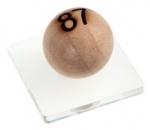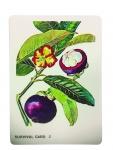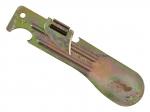Private Errol Noack

Private Errol Noack (right) with his father, Walter (left), and a friend before embarking for service in Vietnam, 1966. (AWM P04010.002)
Errol Noack was born in Adelaide on 28 March 1945, in the last year of the Second World War. His mother, Dorothy, left the family when he was an infant, and so Errol was raised by his father, Walter, with the help of his aunts and uncles.
Compulsory military service, known as the National Service Scheme, came into effect in 1964, and the following year the government introduced powers that allowed it to send national servicemen overseas. Men who had turned 20 (with the exception of serving members of the permanent military forces, non-British migrants, and Indigenous Australians) were required to register for national service. Men were then selected for enlistment by the “birthday ballot”, with 184 numbered balls placed in a barrel, one for each day of a six-month period. Four months after Errol had begun working with his father as a fisherman, number 87 was randomly drawn. This number represented 28 March, Errol’s birthday, and he was drafted into the army for two years of continuous full-time service.
Errol told his local pastor and friend G.E. Fischer: “I don’t want to go to war but I must obey the call to duty. I will go and do my best.”[1] After training at Puckapunyal, he was posted to the 5th Battalion, Royal Australian Regiment (5RAR), as a machine-gunner. After further training in Canungra, Queensland, to learn about operating in a jungle environment, Errol went to stay with his father in Port Lincoln for his final period of leave. He went for a swim and took Holy Communion before flying to Vietnam on 13 May 1966.
Errol Noack in Port Lincoln, South Australia, on his last leave before service in Vietnam, 1966
Errol wrote to his aunt after his first week in Vietnam. He mentioned the daily rain, and the hot tropical sun that dried things out quickly, as well as apologising for his writing and grammar, having consumed quite a few beers after returning from patrol.
On 24 May helicopters flew members of 5RAR from Vung Tau to a landing zone near Nui Dat. The battalion’s A and B Companies were sent to clear an area where the 1st Australian Task Force base was to be built. Errol, Private Kevin Borger, and Private John O’Callaghan were sent forward as part of a listening post, and stopped to refill their water bottles at a creek.
When they returned from the creek, Errol had just asked Kevin how to use their water purification tablets when there was a sudden roar of gunfire, and bullets began landing around them. John told them to “hit the deck”, but it was too late for Errol. Kevin recalled Errol saying, “I can’t feel anything, I’m dying, God help me.”[2]
Errol was flown to hospital at Vung Tau in a medevac helicopter, but died shortly after arrival. Aged 21, he was the first National Serviceman to die in Vietnam. He was just ten days into his service.
It was soon realised that A and B companies had approached the creek junction from opposite directions. A Company had fired upon the B Company listening post, believing it to be the enemy. At the time, the men had been told that the contact was caused by enemy movement between the companies. Kevin believed that he may have been mistaken for a member of the Viet Cong, as he had lost his bush hat earlier in the day, and was told to wrap a sweat rag around his head instead. It was suggested that when the Australian jungle green clothing became wet or sweat-stoked, it looked black, and could be mistaken for the darker clothing worn by enemy fighters.[3] The incident was a terrible shock to the men of 5RAR, and an awful introduction to war for the newly formed battalion.
Even after the fact, Errol’s death was coloured by varying reports. His father was told at one point that Errol was killed by enemy fire when he stood up trying to move position. However, eyewitness accounts by Kevin and John dispute this.
A street named after Errol Noack, in Nuit Dat Vietnam, 1966. (John Bentley)
Errol was buried at Centennial Park Cemetery in Adelaide with full military honours. His father, mourning the loss of his only child, wrote that the TV stations “kindly let me have a film copy of Errol’s funeral, which I prize very much”.[4] Errol’s death became a symbol of the anti-war movement for the Australian public.
The Errol Noack House was opened in Adelaide in 1989, and provided emergency accommodation for veterans and their families. Although the house has since been demolished as part of the Mitchell Park redevelopment, alternative veteran accommodation continues to be provided by RSL League Care SA and Andrew Russell Veteran Living.
Activities
- The Vietnam War was the cause of the greatest social and political dissent in Australia since the conscription referendums of the First World War. Research the definitions of the following terms, and discuss why some Australians did not agree with participation in the Vietnam War:
- Protestor
- Draft resister
- Conscientious objector
Sydney: Comment Publishing Company, Stop the war!, 1970, letterpress on paper, 50.6 x 36.6 cm,
- The anti-conscription poster above includes a collage of newspaper headlines and graffiti.
- Create a list of these words, identify their meanings, and discuss why they would have been included in this poster.
- Create a poster from the opposing perspective. What words will you use to promote Australia’s involvement in the Vietnam War, and the use of conscription? You might like to consider public perception of communism and international alliances.
- What is a moratorium? The orange symbol in the bottom right corner is the Vietnam Moratorium symbol, which promoted three protest marches held in Melbourne in 1970 and 1971. Research these marches. Who participated? What perspectives did the attendees have of the war? How did they choose to show their protest?

Replica lottery ball representing the birthdate of Errol Noack.
The “birthday ballot” was sometimes referred to as “the lottery of death”. However, even if a person was drafted, some were granted deferments and exemptions. Brainstorm some ideas of who was eligible for deferment or exemption. For more information, visit our encyclopedia.

Survival card used to teach troops about plant materials found in south-east Asia.
- Survival cards contained vital information about living in south-east Asia. These cards were created in 1968 and distributed in packs to Australian soldiers serving in Vietnam. What sort of information about Vietnam do you think would be useful for Australian servicemen and servicewomen to know before deployment?
- Find examples of how the environment in Vietnam created additional challenges for those serving. Consider the weather, wildlife, topography, and foliage.

A field ration can opener used in Vietnam.
- This can opener, provided to Australian soldiers during the Vietnam War from 1962 to 1973, is light, multifunctional, and could be used as a spoon. An old saying is that “an army marches on its stomach”. What does this mean?
- Compare and contrast ration packs from the Vietnam War with those from more recent conflict in Afghanistan. Identify similarities and differences. Why do you think these changes were made?
- Design your own ration pack for a serviceperson, with enough nutrients for one day. Consider what country the pack would be used in, and which country the serviceperson might be from.
Additional resources
Australian War Memorial article on Vietnam
Australian War Memorial online exhibition - "A walk in the light green"
https://vietnam.unsw.adfa.edu.au/keeping-the-troops-in-the-field-part-1-rations
Related objects
- Jungle green shirt
- Australian field ration eating device
- Lottery ball
- Survival card
- Magnifying glass
Footnotes
[1] Last Post Ceremony commemorating the service of Private Errol Wayne Noack, 13 February 2015, Australian War Memorial: PAFU2015/053.01.
[2] Australian War Memorial, “Eyewitness accounts of Private Errol Noack’s wounding”, <accessed 10 September 2019>.
[3] Ric Teague, Born on Anzac Day, Rosenberg Publishing, New South Wales, 2015, p. 147.
[4] Walter Noack correspondence, State Library of South Australia, PRG 1452/1/1.
Bibliography
Australian War Memorial, “Eyewitness accounts of Private Errol Noack’s wounding”, <accessed 10 September 2019>.
John Knott, “Noack, Errol Wayne (1945–1966)”, Australian Dictionary of Biography, <accessed 10 September 2019>.
Letter from Errol Noack to his Aunt Lois, c. May 1966, National Vietnam Veterans Museum, Victoria.
Michael Kelly, “Private Errol Noack” Last Post Ceremony story, <accessed 10 September 2019>.
Correspondence of Walter Noack, 1979, State Library of South Australia, PRG 1452/1/1, <accessed 10 September 2019>
Ric Teague, Born on Anzac Day, Rosenberg Publishing, New South Wales, 2015.


